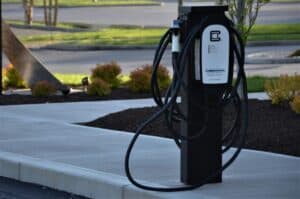Business
Key Considerations for Installing Commercial EV Charging Stations
Table of Contents
- Understanding the Demand for EV Charging Infrastructure
- Evaluating Installation Costs and Incentives
- Choosing the Right Type of Chargers
- Ensuring Compliance with Regulations
- Addressing Safety and Maintenance
- Enhancing User Experience
- Considering Future Scalability
- Assessing Return on Investment
- Final Thoughts
Understanding the Demand for EV Charging Infrastructure
The rapid surge in electric vehicle (EV) ownership transforms consumers’ expectations of commercial spaces. Gone are the days when parking lots only needed to accommodate gasoline-powered vehicles; today, EV charging stations are becoming a marker of progressiveness and customer-centricity. Businesses that provide charging amenities are better positioned to attract customers who prioritize sustainability and innovation, both of which are key considerations for a growing number of consumers. This move isn’t just about environmental consciousness—it’s also a proven method for increasing customer traffic and loyalty. According to research from Consumer Reports, U.S. retailers could see a 4% boost in foot traffic and a 5% uplift in revenue by installing EV charging stations, as this provides clear added value for eco-minded patrons. These figures highlight how green amenities fulfill social responsibility and have clear financial upside.
Additionally, offering a range of DC fast and AC charging systems allows businesses to accommodate various EV models and visiting durations, further expanding their customer base and retention opportunities. By understanding which types of customers you serve and how long they typically stay on your premises, you can better tailor your charging offerings and maximize station usage. Globally, individual consumer preferences and evolving regulatory landscapes drive the demand for more robust EV infrastructure. New regional policies require infrastructure upgrades, and companies that move proactively can get ahead of competitors while catering to modern consumers’ values.
Evaluating Installation Costs and Incentives
The up-front expense is one of the first hurdles businesses face when considering EV charging stations. Installation costs are influenced by the type of charger, site-specific requirements, utility upgrades, trenching, and existing electrical infrastructure. Not only do businesses need to budget for the physical installation, but they also have to factor in wiring, labor, permits, and potential utility service improvements, making it important to work with experienced contractors and engineers in the early planning stages. Fortunately, multiple government incentives exist to help offset these initial costs. For example, the Alternative Fuel Infrastructure Tax Credit provides a 30% tax credit for hardware and installation expenses—capped at $100,000 per unit. Many grants and rebates offered at the state and local level can further reduce capital outlay, making investment in this infrastructure more financially accessible.
Additional state and utility-level incentives are frequently available and can further reduce out-of-pocket costs. Smart budgeting and incentive research are essential first steps when building a business case for commercial EV charging stations. Understanding available credits and accurately estimating installation costs allows decision-makers to assess payback timelines and forecast ROI more realistically. For further guidance on maximizing available incentives, consult resources from the U.S. Department of Energy. Allocating time upfront to navigate these opportunities can result in significant, long-term savings and ensure your project is set up for financial health from day one.
Choosing the Right Type of Chargers
Matching your charger types to customer needs is essential for success. Level 2 chargers, which use a 240V supply, are ideal for workplaces, retail centers, and hospitality venues where vehicles may be parked for several hours. These chargers typically add about 25 miles of range per hour and work best for users who plan to shop, dine, or work for extended periods. On the other hand, DC fast chargers are best for locations near highways or areas where quick turnarounds are expected, as they can replenish a battery in as little as 30 minutes. These high-powered stations are attractive for drivers passing through or making quick stops, and can help draw in a different segment of EV users compared to slower charging options. Providing a strategic mix of both types widens your potential user base and demonstrates your commitment to serving a diverse range of drivers and use cases.
Further, considering the addition of multiple connector types increases utility across various EV brands, enabling your site to become a charging destination for more customers. By assessing patterns in local traffic and visitor behavior, businesses can fine-tune their charger offerings to suit demonstrated customer needs, ensuring maximum utilization and satisfaction.
Ensuring Compliance with Regulations
Each jurisdiction has its own building codes and zoning laws that must be followed during installation, often dictating much more than just the number of chargers. ADA accessibility, setbacks, and utility access points may all come into play. In many cases, regulations now mandate a certain percentage of parking spaces to charge EVs in new or renovated facilities. For instance, new developments in California must allocate at least 10% of parking spaces to EV charging, aligning with growing regulatory requirements seen nationwide. In addition, your site may need to comply with fire codes and signage regulations or coordinate with the local electric utility to ensure safety and effectiveness.
Understanding and adhering to these standards is crucial for a smooth installation process and to avoid costly delays or modifications. Consulting with local municipality offices early in your planning and working with contractors familiar with the latest laws ensures your installation process meets requirements efficiently, minimizing surprises down the road.
Addressing Safety and Maintenance
Safety and reliability are paramount concerns with any electrical installation, and EV charging infrastructure is no exception. A robust installation process ensures chargers operate within manufacturer specifications, protecting hardware and users. Regular maintenance schedules and robust installation and operational oversight are key to ensuring uninterrupted service. Implementing clear policies—such as time limits on charging or prompt removal after charging is complete—helps keep stations readily available for all users and minimizes frustration.
Ongoing technician training and periodic inspections further reduce the risk of outages or hazardous malfunctions, preserving equipment and reputation. Site operators should also prepare an emergency response plan for rare incidents and keep customer support easily accessible. In the long run, a well-maintained charging station enhances safety and extends the lifespan of the infrastructure, providing better value for the business and its customers.
Enhancing User Experience
The best EV charging solutions are easy to find, user-friendly, and reliable. Considerations include:
- Strategic placement in well-lit, easy-to-access areas with clear signage
- Integration with mobile apps for real-time updates, way-finding, and payment processing
- Offering a mix of connector types to serve all major EV manufacturers and models
Focusing on these areas delivers a frictionless charging experience, boosting overall satisfaction and increasing the likelihood of repeat visits. Today’s drivers expect real-time updates on charger status, easy payment methods, and accurate location information, so failing to provide these features can lead to frustration and lost business. Comprehensive user experience design also means offering responsive customer service, reliable uptime, and thoughtful touches like nearby amenities.
Considering Future Scalability
EV adoption is expected to accelerate, so demand for charging infrastructure will also rise. Forward-looking businesses should plan for future expansion by installing scalable systems that make it easy to add more stations without costly overhauls. Selecting modular charging units, reserving physical space and electrical capacity, and planning for smart grid integration all help position businesses to capitalize on future market growth without disruption.
Building flexibility into your charging infrastructure from the outset reduces costs and complexity later, ensuring that your investment can adapt as your customer base grows and technology evolves. Proactive planning for scalability also signals to partners and stakeholders that your business is thinking ahead and ready to meet tomorrow’s needs.
Assessing Return on Investment
Evaluating the ROI of EV charging station installations transcends simple fee collection from users. Businesses frequently see increased customer dwell time, heightened brand awareness, and favorable public relations from being early adopters of green technology. Partnerships with major EV manufacturers and service providers can also open the door to new revenue streams or co-marketing opportunities. For some properties, hosting charging stations can boost leasing activity, increase property values, and help secure sustainability certifications that are attractive to investors. Ultimately, charging infrastructure is a differentiator that supports business growth, attracts eco-conscious clientele, and positions the organization as a leader in environmental stewardship. Measuring ROI should therefore include both financial outcomes and reputational benefits to capture the full impact of your investment.
Final Thoughts
Installing commercial EV charging stations requires a strategic blend of market understanding, cost management, regulatory knowledge, and customer focus. By carefully considering current needs and trends, businesses can offer valuable amenities, future-proof their properties, and foster deeper connections with environmentally aware consumers. The transition to electric mobility presents both a challenge and an opportunity—and the most prepared organizations stand to reap the greatest rewards. As electric vehicles transform transportation, installing the right charging infrastructure sets your business apart and ensures its relevance for years.






